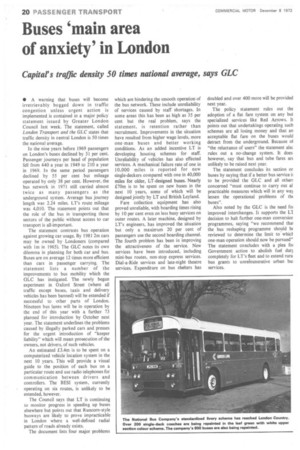Buses 'main area of anxiety' in London
Page 22

If you've noticed an error in this article please click here to report it so we can fix it.
Capital's traffic density 50 times national average, says GLC
• A warning that buses will become irretrievably bogged down in traffic congestion unless urgent action is implemented is contained in a major policy statement issued by Greater London Council last week. The statement, called London Transport and the GLC states that traffic density in central London is 50 times the national average.
In the nine years before 1969 passengers on London's buses declined by 31 per cent. Passenger journeys per head of population fell from 440 a year in 1949 to 210 a year in 1969. In the same period passengers declined by 55 per cent but mileage operated by only 38 per cent. However, the bus network in 1971 still carried almost twice as many passengers as the underground system. Average bus journey length was 2.24 miles. LT's route mileage was 4,010. The statement points out that the role of the bus in transporting those sectors of the public without access to car transport is all-important.
The statement contrasts bus operation against growing car usage. By 1981 2m cars may be owned by Londoners (compared with lm in 1965). The GLC notes its own dilemma in planning for both car and bus. Buses are on average 12 times more efficient than cars in passenger carrying. The statement lists a number of the improvements to bus mobility which the GLC has instigated. The newly begun experiment in Oxford Street (where all traffic except buses, taxis and delivery vehicles has been banned) will be extended if successful to other parts of London. Nineteen bus lanes will be in operation by the end of this year with a further 73 planned for introduction by October next year. The statement underlines the problems caused by illegally parked cars and presses for the urgent introduction of "keeper liability" which will mean prosecution of the owners, not drivers, of such vehicles.
An estimated £3.4m is to be spent on a computerized vehicle location system in the next 10 years. This will provide a visual guide to the position of each bus on a particular route and use radio telephones for communication between drivers and controllers. The BEST system, currently operating on six routes, is unlikely to be extended, however.
The Council says that LT is continuing to monitor progress in speeding up buses elsewhere but points out that Runcorn-style busways are likely to prove impracticable in London where a well-defined radial pattern of roads already exists.
The document lists four major problems which are hindering the smooth operation of the bus network. These include unreliability of services caused by staff shortages. In some areas this has been as high as 35 per cent but the real problem, says the statement, is retention rather than recruitment. Improvements in the situation have resulted from higher wage levels, more one-man buses and better working conditions. As an added incentive LT is developing housing schemes for staff. Unreliability of vehicles has also effected services. A mechanical failure rate of one in 10,000 miles is reported for new single-deckers compared with one in 40,000 miles for older, LT-designed buses, Nearly £.70m is to be spent on new buses in the next 10 years, some of which will be designed jointly by LT and British Leyland.
Fare collection equipment has also proved unreliable, with boarding times rising by 10 per cent even on less busy services on outer routes. A later machine, designed by LT's engineers, has improved the situation but only a maximum 20 per cent of passengers use the second boarding channel. The fourth problem has been in improving the attractiveness of the service. New services have been introduced, including mini-bus routes, non-stop express services. Dial-a-Ride services and late-night theatre services. Expenditure on bus shelters has doubled and over 400 more will be provided next year.
The policy statement rules out the adoption of a flat fare system on any but specialized services like Red Arrows. It points out that undertakings operating such schemes are all losing money and that an acceptable flat fare on the buses would detract from the underground. Because 01 "the reluctance of users" the statement alsc rules out a no-change system. It does however, say that bus and tube fares an unlikely to be raised next year.
The statement concludes its section or buses by saying that if a better bus service to be provided the GLC and all °then concerned "must continue to carry out al practicable measures which will in any way, lessen the operational problems of th( buses".
Also noted by the GLC is the need foi improved interchanges. It supports the LT decision to halt further one-man conversior programmes, saying "we recommend thai the bus reshaping programme should in reviewed to determine the limit to whicl one-man operation should now be pursued" The statement concludes with a plea foi Government action to abolish fuel dut3 completely for LT's fleet and to extend rura bus grants to unreinunerative urban btu services.








































































































